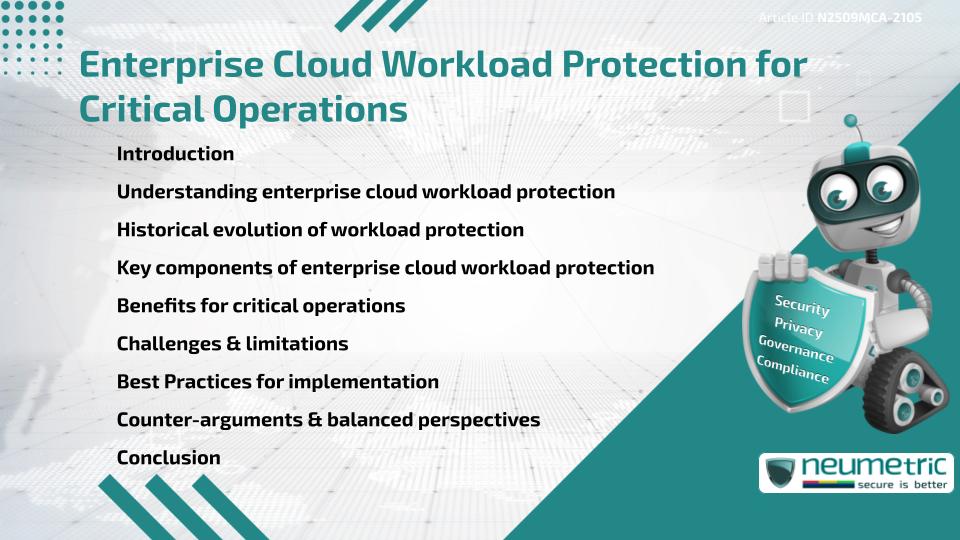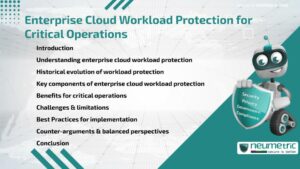Table of Contents
ToggleIntroduction
Enterprise cloud workload protection is essential for Organisations running mission-critical operations in cloud environments. It secures applications, data & services from Cyber Threats, unauthorised access & operational disruptions. With rising adoption of hybrid & multi-cloud platforms, the importance of enterprise cloud workload protection has grown significantly. This article explores its meaning, history, benefits, challenges & Best Practices, providing a balanced view for enterprises seeking robust security.
Understanding enterprise cloud workload protection
Enterprise cloud workload protection refers to the strategies, tools & frameworks that safeguard workloads-applications, services & processes-across cloud infrastructures. Unlike traditional Endpoint Protection, this approach addresses dynamic, distributed & virtualised environments. Workloads can include databases, virtual machines & microservices, all requiring consistent defense measures.
To learn more about workload security concepts, see Cloud Security Alliance, which outlines Best Practices for cloud protection.
Historical evolution of workload protection
The concept of workload protection has evolved alongside IT infrastructures. In the early 2000s, security primarily focused on firewalls & on-premises intrusion detection. As virtualisation & cloud computing became mainstream, traditional security tools struggled to handle scalability & fluidity. This gap led to the emergence of cloud-native workload protection solutions.
Today, enterprise cloud workload protection integrates automation, identity management & real-time monitoring to align with modern DevOps & continuous delivery models.
Key components of enterprise cloud workload protection
Several key elements define an effective workload protection strategy:
- Visibility & monitoring: Continuous tracking of workloads across cloud environments.
- Access Controls: Enforcing least-privilege principles for users & applications.
- Threat detection: Identifying malware, misconfigurations & anomalous behaviour.
- Compliance management: Meeting regulatory requirements like GDPR & HIPAA.
- Automation: Leveraging AI-driven tools for faster response & remediation.
For detailed insights into these components, NIST provides extensive guidance on Cloud Security frameworks.
Benefits for critical operations
Enterprise cloud workload protection provides multiple advantages for critical operations:
- Resilience: Ensures continuity of business functions during cyber incidents.
- Data integrity: Prevents unauthorised alterations of Sensitive Data.
- Compliance adherence: Helps enterprises maintain industry-mandated standards.
- Cost efficiency: Reduces Financial Risks associated with breaches & downtime.
A practical comparison is like having a fire alarm system in a building. While the fire may never occur, the system ensures immediate detection, alerts & response if it does. Similarly, enterprise cloud workload protection safeguards vital digital functions against sudden Threats.
For practical case-based strategies, see ISACA which offers knowledge resources on enterprise-level Cloud Security.
Challenges & limitations
Despite its benefits, enterprise cloud workload protection faces hurdles:
- Complexity: Hybrid & multi-cloud environments increase management difficulty.
- Cost: Advanced protection solutions may strain budgets, especially for mid-sized Organisations.
- False positives: Over-sensitive Threat detection systems can create operational delays.
- Vendor dependency: Reliance on Third Party providers may expose enterprises to additional Risks.
These challenges highlight the need for careful planning & resource allocation.
Best Practices for implementation
To maximise the effectiveness of enterprise cloud workload protection, Organisations should:
- Conduct Risk Assessments to identify vulnerable workloads.
- Implement zero-trust security models.
- Automate security updates & Patch Management.
- Train staff regularly to identify & prevent Security Incidents.
- Choose solutions that integrate with existing IT ecosystems.
A good starting point is the CIS Center for Internet Security, which offers benchmarks & controls for enterprise security.
Counter-arguments & balanced perspectives
Some argue that enterprise cloud workload protection is overemphasised, claiming that cloud service providers already include strong Security Measures. While providers like AWS & Azure deliver robust native tools, shared responsibility models clarify that enterprises must secure their own workloads. Therefore, enterprise cloud workload protection complements, rather than duplicates, provider security.
Another perspective questions the cost-to-benefit ratio, particularly for smaller enterprises. However, the high costs of breaches, reputational damage & regulatory fines often outweigh upfront expenses.
Conclusion
Enterprise cloud workload protection is not optional for critical operations-it is foundational. By combining visibility, automation & compliance, enterprises strengthen their resilience against evolving Cyber Threats.
Takeaways
- Enterprise cloud workload protection secures applications, data & services in cloud environments.
- Its evolution reflects shifts from traditional to cloud-native infrastructures.
- Core components include monitoring, Access Control, detection, compliance & automation.
- It offers resilience, compliance & cost benefits for critical operations.
- Challenges exist, but Best Practices ensure successful implementation.
FAQ
What is enterprise cloud workload protection?
It is the security strategy that safeguards workloads-applications, data & services-operating in cloud environments.
Why is enterprise cloud workload protection important for critical operations?
It ensures resilience, compliance & data integrity, protecting essential business functions from disruption.
How does enterprise cloud workload protection differ from traditional security?
Unlike traditional systems, it secures dynamic, distributed & virtualised cloud workloads rather than fixed endpoints.
What are the main challenges in adopting enterprise cloud workload protection?
Key challenges include cost, complexity, false positives & reliance on Third Party vendors.
Do cloud providers not already secure workloads?
Providers offer strong security tools, but under the shared responsibility model, enterprises must secure their own workloads too.
How can Organisations implement enterprise cloud workload protection effectively?
They can use Risk Assessments, zero-trust models, automation, training & integrated solutions to strengthen protection.
Does enterprise cloud workload protection improve compliance?
Yes, it helps Organisations meet standards like GDPR & HIPAA by monitoring, reporting & enforcing Policies.
Need help for Security, Privacy, Governance & VAPT?
Neumetric provides organisations the necessary help to achieve their Cybersecurity, Compliance, Governance, Privacy, Certifications & Pentesting needs.
Organisations & Businesses, specifically those which provide SaaS & AI Solutions in the Fintech, BFSI & other regulated sectors, usually need a Cybersecurity Partner for meeting & maintaining the ongoing Security & Privacy needs & requirements of their Enterprise Clients & Privacy conscious Customers.
SOC 2, ISO 27001, ISO 42001, NIST, HIPAA, HECVAT, EU GDPR are some of the Frameworks that are served by Fusion – a SaaS, multimodular, multitenant, centralised, automated, Cybersecurity & Compliance Management system.
Neumetric also provides Expert Services for technical security which covers VAPT for Web Applications, APIs, iOS & Android Mobile Apps, Security Testing for AWS & other Cloud Environments & Cloud Infrastructure & other similar scopes.
Reach out to us by Email or filling out the Contact Form…





